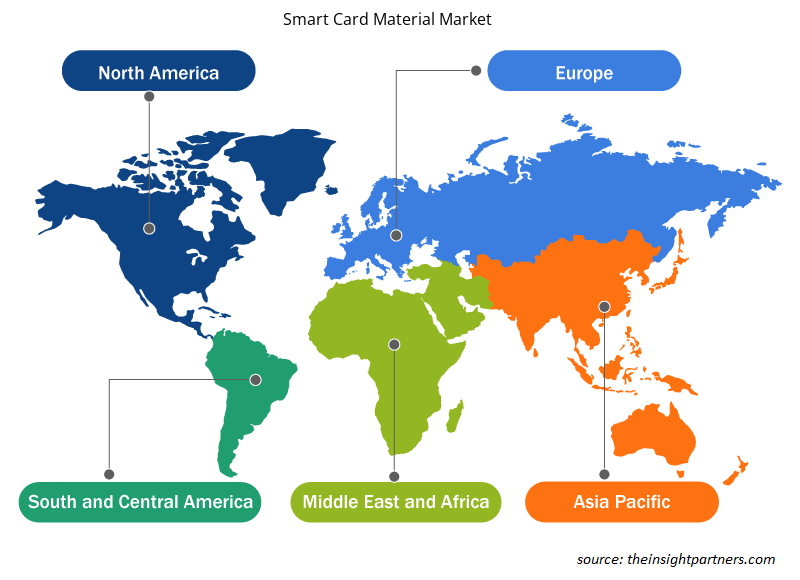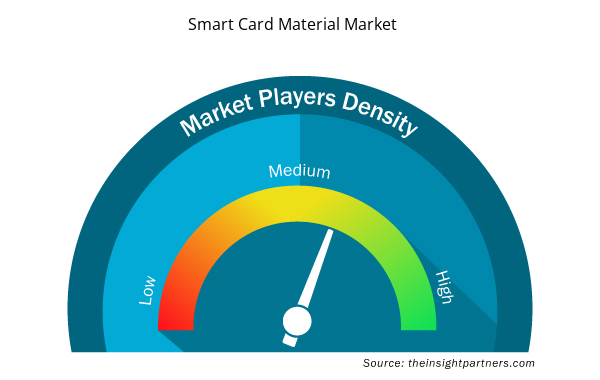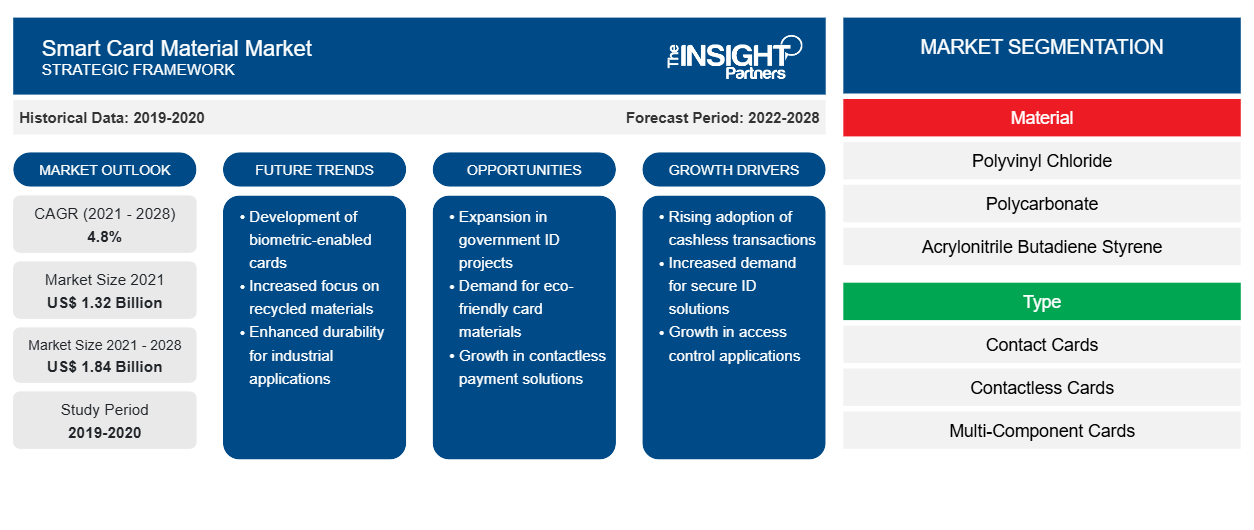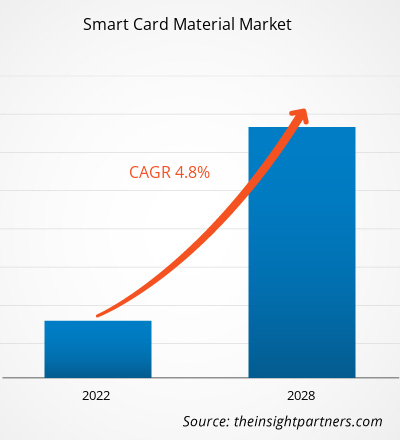من المتوقع أن يصل سوق مواد البطاقات الذكية إلى 1،837.78 مليون دولار أمريكي بحلول عام 2028 من 1324.57 مليون دولار أمريكي في عام 2021؛ ومن المتوقع أن ينمو بمعدل نمو سنوي مركب قدره 4.8٪ من عام 2021 إلى عام 2028.
البطاقة الذكية، وهي نوع من بطاقات الشريحة، هي بطاقة بلاستيكية تحتوي على شريحة كمبيوتر مدمجة إما من نوع الذاكرة أو المعالج الدقيق والتي تخزن البيانات وتتعامل معها. وعادة ما ترتبط هذه البيانات إما بالقيمة أو بالمعلومات، أو بكليهما، والتي يتم تخزينها ومعالجتها داخل الشريحة. تشير مواد البطاقة الذكية إلى المواد الكيميائية المستخدمة في تصنيع هذه البطاقات. تدعم هذه المواد تضمين المعلومات وطباعتها عليها.
في عام 2020، استحوذت منطقة آسيا والمحيط الهادئ على أكبر حصة من سوق مواد البطاقات الذكية العالمية . ويتزايد الطلب على مواد البطاقات الذكية في هذه المنطقة بسبب الاستخدام المتزايد للبطاقات الذكية في قطاع الاتصالات. بالإضافة إلى ذلك، فإن اتجاه العولمة المتزايد؛ وانتشار صناعة الخدمات المصرفية والمالية والتأمين (BFSI) هي عوامل رئيسية تدعم نمو سوق مواد البطاقات الذكية في المنطقة.
قم بتخصيص هذا التقرير ليناسب متطلباتك
ستحصل على تخصيص لأي تقرير - مجانًا - بما في ذلك أجزاء من هذا التقرير، أو تحليل على مستوى الدولة، وحزمة بيانات Excel، بالإضافة إلى الاستفادة من العروض والخصومات الرائعة للشركات الناشئة والجامعات
- احصل على أهم اتجاهات السوق الرئيسية لهذا التقرير.ستتضمن هذه العينة المجانية تحليلاً للبيانات، بدءًا من اتجاهات السوق وحتى التقديرات والتوقعات.
تأثير جائحة كوفيد-19 على سوق مواد البطاقات الذكية
لقد غير جائحة كوفيد-19 المستمر بشكل كبير وضع قطاع المواد الكيميائية والمواد وأثر على نمو سوق مواد البطاقات الذكية. وقد أثر الانخفاض الكبير في أداء العديد من القطاعات الصناعية على الطلب على مواد البطاقات الذكية. ويختلف تأثير الوباء عبر قطاعات التطبيق المختلفة. وقد استفاد العديد من شركات الاتصالات من زيادة حركة البيانات والخدمات الصوتية، بما في ذلك مشغلو مراكز البيانات ذات النطاق العريض والمتنقلة. ومع ذلك، فإن تدابير الإغلاق التي فرضتها الحكومات أزعجت سلاسل توريد المواد الخام مثل PVS وABS وPETG المطلوبة لتصنيع البطاقات الذكية. وقد أثر انتشار المرض سلبًا على العمليات في قطاعي الحكومة والخدمات المصرفية والمالية والتأمين. ومع ذلك، نظرًا لأن الاقتصادات تخطط لإحياء عملياتها، فمن المتوقع أن يرتفع الطلب على مواد البطاقات الذكية عالميًا في السنوات القادمة.
رؤى السوق
نمو ملحوظ في قطاعي الاتصالات والرعاية الصحية
تُستخدم البطاقات الذكية على نطاق واسع في قطاع الاتصالات. وأبرز استخدام للبطاقات الذكية في هذا القطاع هو في شكل بطاقات وحدة هوية المشترك (SIM) أو بطاقات الدوائر المتكاملة العالمية (UICC). تُصنع هذه البطاقات الذكية في الغالب من مواد البولي فينيل كلوريد (PVC) وأكريلونيتريل بوتادين ستايرين (ABS). وقد خضعت تقنية البطاقات الذكية المستخدمة في التطبيقات في هذا القطاع لتطورات مستمرة في السنوات العديدة الماضية، مما أدى إلى زيادة استهلاك هذه البطاقات. علاوة على ذلك، تنفذ منظمات الرعاية الصحية في جميع أنحاء العالم بطاقات صحية ذكية بمجموعة واسعة من الميزات والتطبيقات.
رؤى إقليمية حول سوق مواد البطاقات الذكية
لقد قام المحللون في Insight Partners بشرح الاتجاهات والعوامل الإقليمية المؤثرة على سوق مواد البطاقات الذكية طوال فترة التوقعات بشكل شامل. يناقش هذا القسم أيضًا قطاعات سوق مواد البطاقات الذكية والجغرافيا في جميع أنحاء أمريكا الشمالية وأوروبا ومنطقة آسيا والمحيط الهادئ والشرق الأوسط وأفريقيا وأمريكا الجنوبية والوسطى.

- احصل على البيانات الإقليمية المحددة لسوق مواد البطاقات الذكية
نطاق تقرير سوق مواد البطاقات الذكية
| سمة التقرير | تفاصيل |
|---|---|
| حجم السوق في عام 2021 | 1.32 مليار دولار أمريكي |
| حجم السوق بحلول عام 2028 | 1.84 مليار دولار أمريكي |
| معدل النمو السنوي المركب العالمي (2021 - 2028) | 4.8% |
| البيانات التاريخية | 2019-2020 |
| فترة التنبؤ | 2022-2028 |
| القطاعات المغطاة | حسب المادة
|
| المناطق والدول المغطاة | أمريكا الشمالية
|
| قادة السوق وملفات تعريف الشركات الرئيسية |
|
كثافة اللاعبين في سوق مواد البطاقات الذكية: فهم تأثيرها على ديناميكيات الأعمال
يشهد سوق مواد البطاقات الذكية نموًا سريعًا، مدفوعًا بالطلب المتزايد من المستخدم النهائي بسبب عوامل مثل تفضيلات المستهلك المتطورة والتقدم التكنولوجي والوعي المتزايد بفوائد المنتج. ومع ارتفاع الطلب، تعمل الشركات على توسيع عروضها والابتكار لتلبية احتياجات المستهلكين والاستفادة من الاتجاهات الناشئة، مما يؤدي إلى زيادة نمو السوق.
تشير كثافة اللاعبين في السوق إلى توزيع الشركات أو المؤسسات العاملة في سوق أو صناعة معينة. وهي تشير إلى عدد المنافسين (اللاعبين في السوق) الموجودين في مساحة سوق معينة نسبة إلى حجمها أو قيمتها السوقية الإجمالية.
الشركات الرئيسية العاملة في سوق مواد البطاقة الذكية هي:
- شركة ايستمان للكيماويات
- شركة بتروتشاينا المحدودة
- شركة سولفاي
- كيم واحد
- سابك
إخلاء المسؤولية : الشركات المذكورة أعلاه ليست مرتبة بأي ترتيب معين.

- احصل على نظرة عامة على أهم اللاعبين الرئيسيين في سوق مواد البطاقات الذكية
رؤى التطبيق
بناءً على التطبيق، يتم تقسيم سوق مواد البطاقات الذكية إلى BFSI والحكومة والاتصالات والتجزئة والرعاية الصحية والضيافة وغيرها. احتل قطاع الاتصالات أكبر حصة في سوق مواد البطاقات الذكية في عام 2020. تُستخدم البطاقة الذكية كبطاقات هاتف مدفوعة مسبقًا (بطاقات ذاكرة ذات قيمة مخزنة) وبطاقات SIM أو UICC تعتمد على بطاقة ذكية للمعالج الدقيق في الهواتف المحمولة. أكثر منتجات البطاقات الذكية مبيعًا في هذا القطاع هي SIM وUICC، من حيث الحجم والقيمة.
تشمل بعض الشركات العاملة في سوق مواد البطاقات الذكية العالمية شركة Eastman Chemical Company، وشركة PetroChina Company Limited، وشركة Solvay SA، وشركة KEM ONE، وشركة SABIC، وشركة 3A Composites GmbH، وشركة Teijin Limited، وشركة LG Chem، وشركة BASF SE، وشركة Westlake Chemical Corporation.
تقرير يسلط الضوء على
- اتجاهات الصناعة التقدمية في سوق مواد البطاقات الذكية لمساعدة اللاعبين على تطوير استراتيجيات فعالة طويلة الأجل
- استراتيجيات نمو الأعمال التي تتبناها الشركات العاملة في الأسواق المتقدمة والنامية
- التحليل الكمي لسوق مواد البطاقات الذكية من 2019 إلى 2028
- تقدير الطلب العالمي على مواد البطاقات الذكية
- تحليل القوى الخمس لبورتر لتوضيح فعالية المشترين والموردين العاملين في الصناعة
- التطورات الأخيرة لفهم سيناريو السوق التنافسي
- اتجاهات السوق وتوقعاته بالإضافة إلى العوامل التي تدفع وتكبح نمو سوق مواد البطاقات الذكية
- المساعدة في عملية اتخاذ القرار من خلال تسليط الضوء على استراتيجيات السوق التي تدعم المصلحة التجارية، مما يؤدي إلى نمو سوق مواد البطاقات الذكية
- حجم سوق مواد البطاقات الذكية في العقد المختلفة
- نظرة عامة مفصلة وتقسيم السوق، بالإضافة إلى ديناميكيات صناعة مواد البطاقات الذكية
- حجم سوق مواد البطاقات الذكية في مختلف المناطق مع فرص نمو واعدة
سوق مواد البطاقات الذكية
حسب المادة
- بولي فينيل كلوريد (PVC)
- البولي كربونات (PC)
- أكريلونيتريل بوتادين ستايرين (ABS)
- بولي إيثيلين تيريفثالات جليكول (PETG)
- آحرون
حسب النوع
- بطاقات الاتصال
- البطاقات اللاتلامسية
- بطاقات متعددة المكونات
حسب الطلب
- الخدمات المالية والمصرفية والتأمين
- حكومة
- اتصالات
- بيع بالتجزئة
- الرعاية الصحية
- ضيافة
- آحرون
نبذة عن الشركة
- شركة ايستمان للكيماويات
- شركة بتروتشاينا المحدودة
- شركة سولفاي
- كيم واحد
- سابك
- شركة 3A للمركبات المحدودة
- شركة تيجين المحدودة
- إل جي كيم
- باسف اس اي
- شركة ويستليك للكيماويات
- التحليل التاريخي (سنتان)، السنة الأساسية، التوقعات (7 سنوات) مع معدل النمو السنوي المركب
- تحليل PEST و SWOT
- حجم السوق والقيمة / الحجم - عالميًا وإقليميًا وقطريًا
- الصناعة والمنافسة
- مجموعة بيانات Excel



Report Coverage
Revenue forecast, Company Analysis, Industry landscape, Growth factors, and Trends

Segment Covered
This text is related
to segments covered.

Regional Scope
North America, Europe, Asia Pacific, Middle East & Africa, South & Central America

Country Scope
This text is related
to country scope.
الأسئلة الشائعة
The contactless cards segment is the fastest growing segment in the global smart card material market during the forecasted period. Contactless cards are the smart cards with contactless credentials and have a size like credit cards or debit cards. The market for the contactless cards segment is growing due to its various benefits.
The telecommunication segment held the largest share of the market in 2021. In the telecommunication industry, smart cards are used in two primary applications. Firstly, it is used as prepaid (stored value memory cards) telephone cards and as the microprocessor smart card-based subscriber identity module (SIM) or universal integrated circuit card (UICC) in mobile phones.
The contact cards segment held the largest share of the market in 2021. Contact cards are the smart cards that have a size like conventional debit and credit card. Contact smart card contains a single, embedded, and integrated circuit chip that consists of either memory or memory plus microprocessor.
The polyvinyl chloride segment held the largest share of the global smart card material market in 2021. Polyvinyl chloride is the most common and strong plastic material used for card manufacturing. The material is used for contact and contactless cards.
The major players operating in the global smart card material market are Eastman Chemical Company; PetroChina Company Limited; Solvay S.A.; KEM ONE; SABIC; 3A Composites GmbH; Teijin Limited; LG Chem; BASF SE; and Westlake Chemical Corporation; among others.
In 2021, Asia Pacific held the largest share of the global smart card material market. The major factor driving the smart card materials market in the Asia Pacific region is the increasing use of smart cards in various applications such as government, transportation, retail, and education sectors.
Trends and growth analysis reports related to Chemicals and Materials : READ MORE..
The List of Companies - Smart Card Materials Market
- Eastman Chemical Company
- PetroChina Company Limited
- Solvay S.A.
- KEM ONE
- SABIC
- 3A Composites GmbH
- Teijin Limited
- LG Chem
- BASF SE
- Westlake Chemical Corporation
The Insight Partners performs research in 4 major stages: Data Collection & Secondary Research, Primary Research, Data Analysis and Data Triangulation & Final Review.
- Data Collection and Secondary Research:
As a market research and consulting firm operating from a decade, we have published and advised several client across the globe. First step for any study will start with an assessment of currently available data and insights from existing reports. Further, historical and current market information is collected from Investor Presentations, Annual Reports, SEC Filings, etc., and other information related to company’s performance and market positioning are gathered from Paid Databases (Factiva, Hoovers, and Reuters) and various other publications available in public domain.
Several associations trade associates, technical forums, institutes, societies and organization are accessed to gain technical as well as market related insights through their publications such as research papers, blogs and press releases related to the studies are referred to get cues about the market. Further, white papers, journals, magazines, and other news articles published in last 3 years are scrutinized and analyzed to understand the current market trends.
- Primary Research:
The primarily interview analysis comprise of data obtained from industry participants interview and answers to survey questions gathered by in-house primary team.
For primary research, interviews are conducted with industry experts/CEOs/Marketing Managers/VPs/Subject Matter Experts from both demand and supply side to get a 360-degree view of the market. The primary team conducts several interviews based on the complexity of the markets to understand the various market trends and dynamics which makes research more credible and precise.
A typical research interview fulfils the following functions:
- Provides first-hand information on the market size, market trends, growth trends, competitive landscape, and outlook
- Validates and strengthens in-house secondary research findings
- Develops the analysis team’s expertise and market understanding
Primary research involves email interactions and telephone interviews for each market, category, segment, and sub-segment across geographies. The participants who typically take part in such a process include, but are not limited to:
- Industry participants: VPs, business development managers, market intelligence managers and national sales managers
- Outside experts: Valuation experts, research analysts and key opinion leaders specializing in the electronics and semiconductor industry.
Below is the breakup of our primary respondents by company, designation, and region:

Once we receive the confirmation from primary research sources or primary respondents, we finalize the base year market estimation and forecast the data as per the macroeconomic and microeconomic factors assessed during data collection.
- Data Analysis:
Once data is validated through both secondary as well as primary respondents, we finalize the market estimations by hypothesis formulation and factor analysis at regional and country level.
- Macro-Economic Factor Analysis:
We analyse macroeconomic indicators such the gross domestic product (GDP), increase in the demand for goods and services across industries, technological advancement, regional economic growth, governmental policies, the influence of COVID-19, PEST analysis, and other aspects. This analysis aids in setting benchmarks for various nations/regions and approximating market splits. Additionally, the general trend of the aforementioned components aid in determining the market's development possibilities.
- Country Level Data:
Various factors that are especially aligned to the country are taken into account to determine the market size for a certain area and country, including the presence of vendors, such as headquarters and offices, the country's GDP, demand patterns, and industry growth. To comprehend the market dynamics for the nation, a number of growth variables, inhibitors, application areas, and current market trends are researched. The aforementioned elements aid in determining the country's overall market's growth potential.
- Company Profile:
The “Table of Contents” is formulated by listing and analyzing more than 25 - 30 companies operating in the market ecosystem across geographies. However, we profile only 10 companies as a standard practice in our syndicate reports. These 10 companies comprise leading, emerging, and regional players. Nonetheless, our analysis is not restricted to the 10 listed companies, we also analyze other companies present in the market to develop a holistic view and understand the prevailing trends. The “Company Profiles” section in the report covers key facts, business description, products & services, financial information, SWOT analysis, and key developments. The financial information presented is extracted from the annual reports and official documents of the publicly listed companies. Upon collecting the information for the sections of respective companies, we verify them via various primary sources and then compile the data in respective company profiles. The company level information helps us in deriving the base number as well as in forecasting the market size.
- Developing Base Number:
Aggregation of sales statistics (2020-2022) and macro-economic factor, and other secondary and primary research insights are utilized to arrive at base number and related market shares for 2022. The data gaps are identified in this step and relevant market data is analyzed, collected from paid primary interviews or databases. On finalizing the base year market size, forecasts are developed on the basis of macro-economic, industry and market growth factors and company level analysis.
- Data Triangulation and Final Review:
The market findings and base year market size calculations are validated from supply as well as demand side. Demand side validations are based on macro-economic factor analysis and benchmarks for respective regions and countries. In case of supply side validations, revenues of major companies are estimated (in case not available) based on industry benchmark, approximate number of employees, product portfolio, and primary interviews revenues are gathered. Further revenue from target product/service segment is assessed to avoid overshooting of market statistics. In case of heavy deviations between supply and demand side values, all thes steps are repeated to achieve synchronization.
We follow an iterative model, wherein we share our research findings with Subject Matter Experts (SME’s) and Key Opinion Leaders (KOLs) until consensus view of the market is not formulated – this model negates any drastic deviation in the opinions of experts. Only validated and universally acceptable research findings are quoted in our reports.
We have important check points that we use to validate our research findings – which we call – data triangulation, where we validate the information, we generate from secondary sources with primary interviews and then we re-validate with our internal data bases and Subject matter experts. This comprehensive model enables us to deliver high quality, reliable data in shortest possible time.


 احصل على عينة مجانية لهذا التقرير
احصل على عينة مجانية لهذا التقرير